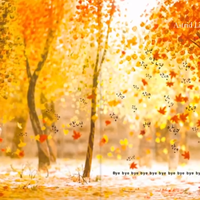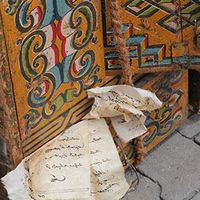#peripheries: The Sensible Archery / The Archery is Sensibility | Mongolia
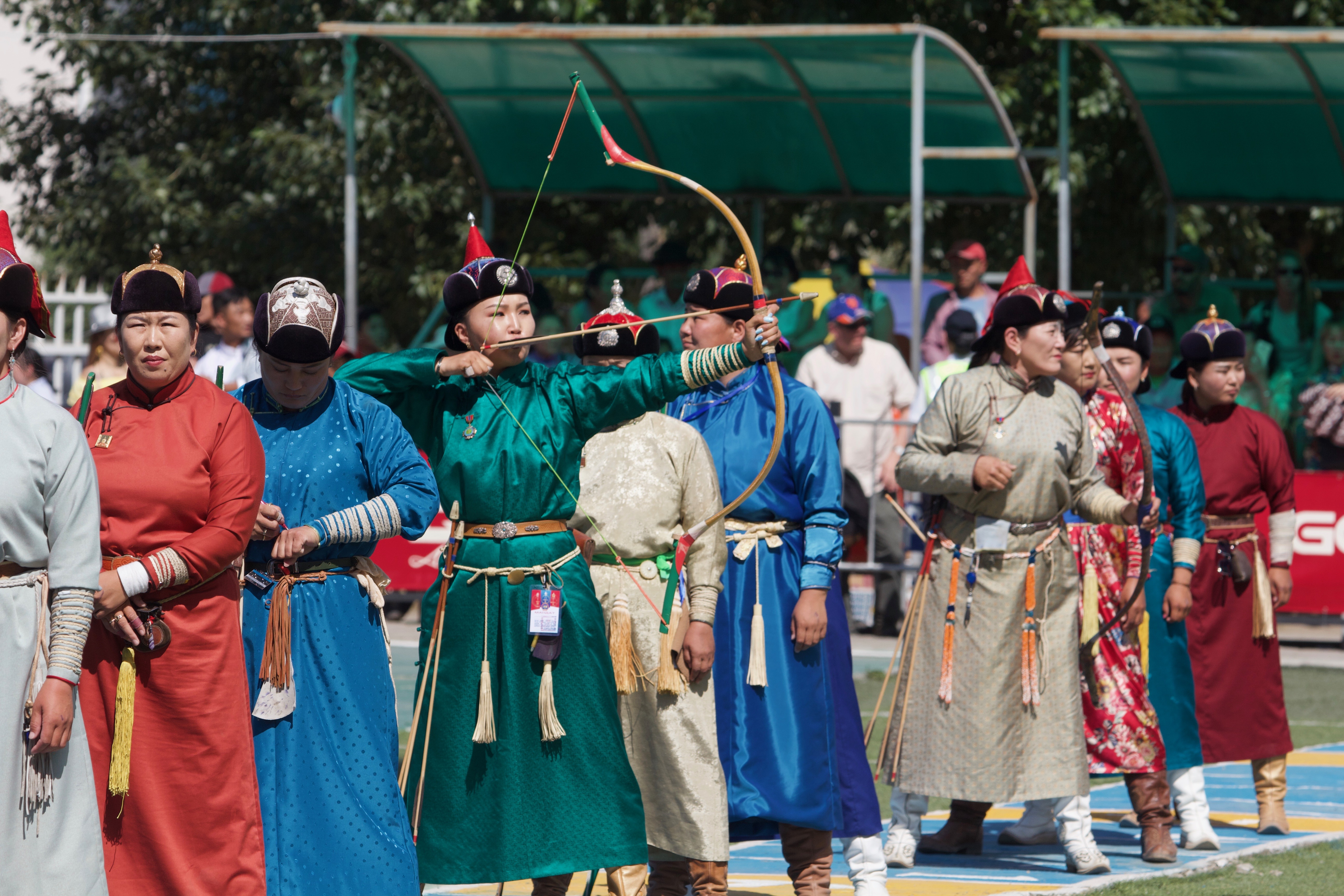
culture360.ASEF.org is featuring a new series of articles on the topic of #peripheries. The #peripheries have been regarded as being in the geographical margin, distant from the capital cities and cultural centres of countries. With an ongoing decentralisation trend, through this series of articles, we will look at various arts endeavours by artists, cultural professionals and art organisations who operate or occupy the peripheries in an urban society and the role that the arts play. In this article, Suvdantsetseg Tsagaanbaatar explores Mongolian archery, one of the oldest traditions of Mongolian nomads and registered as the Intangible Cultural Heritage of Humanity by UNESCO in 2010 as a part of Naadam, Mongolian Traditional Festival.
“Mongolian archery can be said to be sensible archery” U.Sosorburam, archer and a member of Mongolian National Archery Association’s Commission said. Mongolian archers shoot with horn bows made by natural materials of wood, horn and sinew. As such, depending on the weather conditions, bows fluctuate. In colder weather, horn bows become stronger and hard, but in warmer conditions, it gets soft and there is a lower probability of hitting the target. “Except archers’ strengths and skills, a lot of experience and calculations of weather conditions such as wind, temperature, etc. are required to hit the target in order to get points” D.Erdenezuu, archer and bowyer, said. “It takes six months to a year to make one horn bow”.
Each year from July 11-13, Mongolians celebrate the National Festival – Naadam. Mongolians also call this festival “Three games of men”, which refers to wrestling, horse racing and archery. These three games have a longstanding history with Mongolian culture. For nomadic tribes, archery was used as the main tool for hunting animals for food and protection from external threats.
In modern era, Mongolians compete using archery to see how good of a marksman they are. Archery competitions are categorized by children and adults. Children start to shoot when they are 2 or 3 years old. This year, the oldest archer was 78 years old man and the youngest archer was 3 years old. Archers say that there are no age limits in archery, archers can shoot, until when your strength allows you.
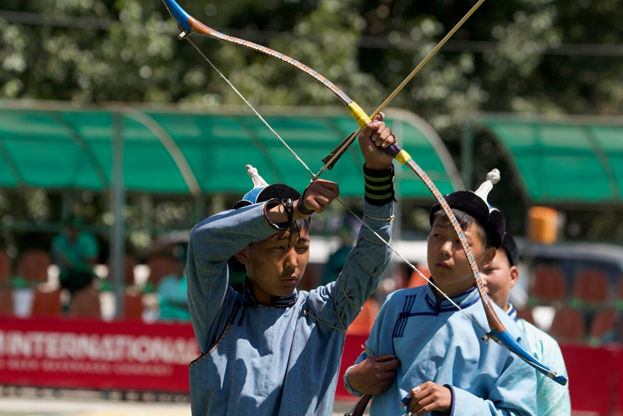
Children archers preparing for the competition
This year, 167 young archers from ages 3 to 17 years old and 540 adult archers competed in Naadam. In the case of young archers, depending on their ages (up to 8, 9-11, 12-14, 15-17), their target distances differ from 3 to 65 meters. Girls’ target distance is 3 times longer than their ages, but boys’ target distance is 4 times.
T.Anujin, 16 year old girl, said that “Archery is one way for me to spend my summer vacation in an interesting manner. Also, while participating in archery competitions, it requires communication and interaction with many people. It then helped me to open up myself. The archery sport challenges my tolerance. That is why I like archery”. It was her 6th Naadam archery competition and her arrows hit 26 of 32 arrows in total.
“This spring, the National Archery Association of Mongolia made a decision to allow children to shoot with educational bows in the Naadam in order to promote children’s interest in the traditional archery” U.Sosorburam, archer and a member of Mongolian National Archery Association’s Commission said. “Children grow faster, so they need new horn bows in a shorter period of time. Also, there are not many bowyers make kids horn bows. ''
While children are now allowed to shoot with educational bows, all adult archers are required to shoot with horn bows and arrows made only in Mongolia for competitions organised within Mongolia according to the Association’s rule. “This rule is followed in order to keep Mongolian traditional bows and its unique style, also to introduce Mongolian archery more” U.Sosorburam said.
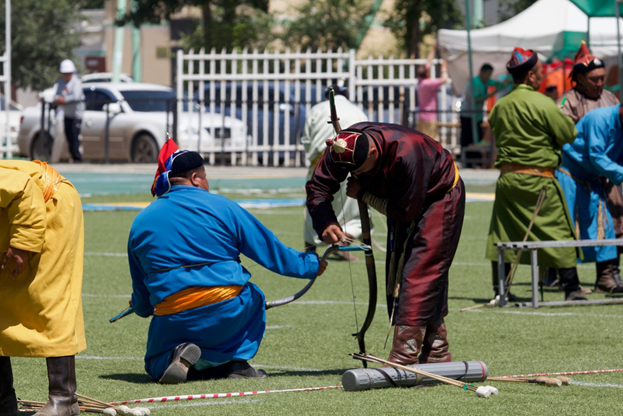
Adult archers preparing their horn bows for the competition
Throughout the year, around 20-30 archery competitions, including a national champion, are organised in Mongolia. Mongolia keeps its three types of archery styles which are Uriankhai archery, Buriad archery and Khalkh archery. Uriankhai, Buriad and Khalkh are tribe’ names of Mongolia. Each having their own styles and specifics.
Uriankhai archery is considered harder than other archery styles and only men shoot. Uriankhai archery’s target distance is 40 meters, in order to get points, archers should hit the target balls made by a leather strap, which is called “chikh” in Uriankhai dialect and weigh 350-400 grams, first. Balls should then roll over 20 cm small mound of soil behind the aligned balls.
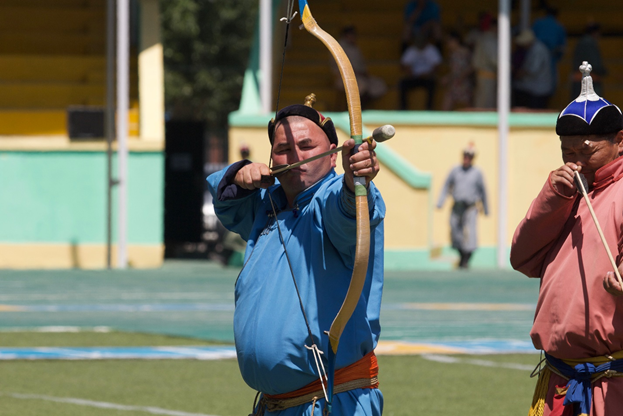
Archer shooting in Uriankhai style archery
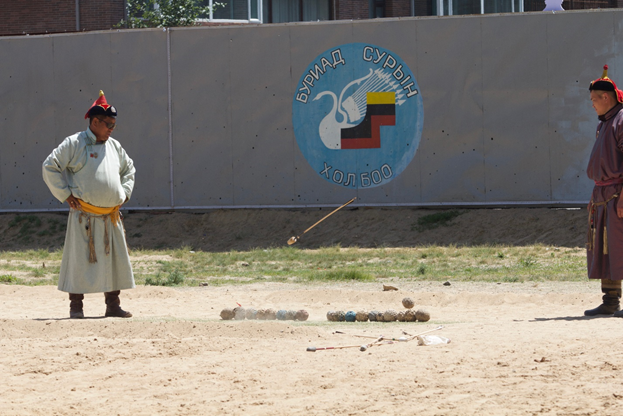
When a 350-400 grams of leather strap ball roll over a 20cm small mound of soil,
the archer will be awarded points
In Buriad and Khalkh archery, both men and women can compete. Women’s target distance is 30 meters in Buriad archery, but 65 meters in Khalkh archery. Men shoot from 45 meters in Buriad archery and 75 meters in Khalkh archery.
The archery competition during the Naadam is special. Archers of first three places in Khalkh archery receive a state marksman or markswoman title only during the Naadam from the President of Mongolia. On Naadam days, archers get fully dressed in traditional costumes and wear traditional hats. Red ribbon on their hats can tell their rank in the archery. More yellow strips in their ribbon, they are acknowledged state marksman/markswoman.
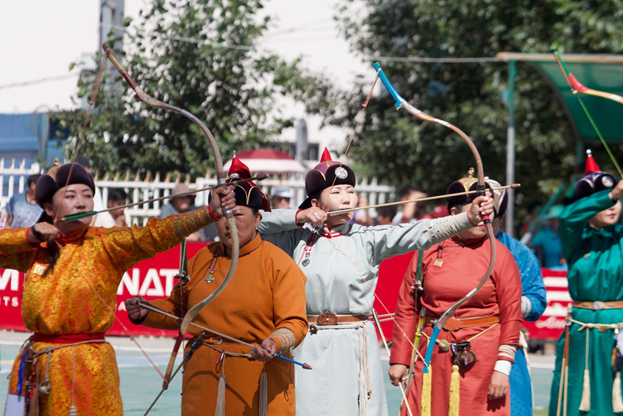
Archers shooting in Khalkh style archery
On the archery field, fully dressed and equipped archers stand on one side and archers without bows and arrows, who are called “surchid” in Mongolian language, stand next to the target line. Target lines are stacked with small 8x8 cm leather cylinders, which are named “khasaa”. Archers stand four by four in one row starting from their ranks. An archer with the highest rank starts shooting. Then, surchid next to the target line show hand or body gestures to tell whether an arrow hit the target or not. Surchid display different body gestures when an arrow hits the khasaa.
For instance, if an arrow hits khasaa well, all surchid raise their two hands with the palms up and say “uukhai” loudly. If not, surchid gesture differently whether the arrow flies over khasaa or short of khasaa. Mongolian traditonal units of measurements, such as ald, delem, etc., are used to show how short the arrow was. Surchid’s body gestures are important signs for archers to calculate their next shot and at the same time, it’s easy for audiences to understand how good shot it was.
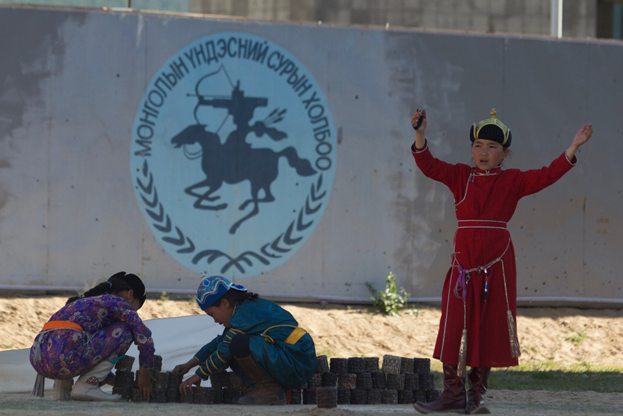
Girl shouts “Uukhai” and her hand gesture tells us that an arrow has hit the target successfully
Archers use traditional terms of Mongolian archery such as uukhai, khasaa and traditional units of measurements while they participate in archery competitions. “I wish people won’t forget special terms or words used for each style of archery. I think while practicing archery, learning archery related words and ethics are authentic ways to keep our intangible cultural heritage. For instance, how nice if one Khalkh man learns Uriankhai dialect and other archery words while shooting in Uriankhai archery. Real value of archery stays here” M.Batgerel, state marksman of all archery styles – Uriankhai, Buriad and Khalkh archery, said.
This article is written by Suvdantsetseg Tsagaanbaatar, a journalist, researcher at the Mongolian Center for Investigative Reporters (MCIR). She is based in Ulaanbaatar, Mongolia. Before joining the MCIR, she worked as a journalist at mining magazine and covered mining related news and articles. Early in her career, she was a coordinator for National Geographic magazine’s Mongolian edition and researcher focuses on Northeast Asian security issues at Strategic Institute of Mongolia, and several other research projects. Later, based on her research skills, she found interest to work in the journalism sector. She hopes to contribute to social progress in Mongolia through her works by using her background in international economic relations and journalism.
Similar content
posted on
06 Apr 2020
deadline
15 Dec 2018
deadline
20 Dec 2013
24 Aug 2019

